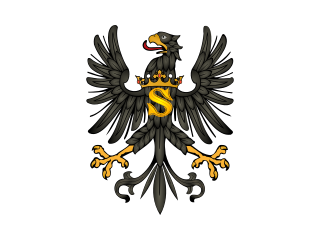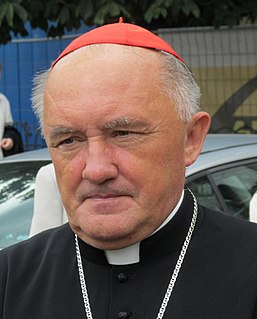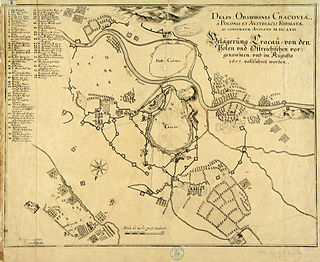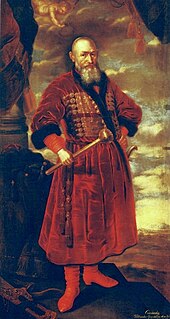Related Research Articles

The Duchy of Prussia or Ducal Prussia was a duchy in the region of Prussia established as a result of secularization of the Monastic Prussia, the territory that remained under the control of the State of the Teutonic Order until the Protestant Reformation in 1525.

The Deluge was a series of mid-17th-century military campaigns in the Polish–Lithuanian Commonwealth. In a wider sense it applies to the period between the Khmelnytsky Uprising of 1648 and the Truce of Andrusovo in 1667, thus comprising the Polish theatres of the Russo-Polish and Second Northern Wars. In a stricter sense, the term refers to the Swedish invasion and occupation of the Commonwealth as a theatre of the Second Northern War (1655–1660) only; in Poland and Lithuania this period is called the Swedish Deluge, or less commonly the Russo–Swedish Deluge due to the simultaneous Russo-Polish War. The term "deluge" was popularized by Henryk Sienkiewicz in his novel The Deluge (1886).

Stanisław Jan Dziwisz is a Polish prelate of the Catholic Church. He served as Archbishop of Kraków from 2005 until 2016. He was created a cardinal in 2006. He was a long-time and influential aide to Pope John Paul II, a friend of Pope Benedict XVI, and an ardent supporter of John Paul II's beatification.

Stanislaus of Szczepanów was Bishop of Kraków known chiefly for having been martyred by the Polish king Bolesław II the Generous. Stanislaus is venerated in the Roman Catholic Church as Saint Stanislaus the Martyr.

The Archbishop of Kraków is the head of the archdiocese of Kraków. A bishop of Kraków first came into existence when the diocese was created in 1000; it was promoted to an archdiocese on 28 October 1925. Due to Kraków's role as Poland's political, cultural and spiritual center, the bishops and archbishops of Kraków were often very influential in the city, country and abroad. From 1443 to 1791, bishops of Kraków were simultaneously Dukes of Siewierz, although it was only Adam Stefan Sapieha who officially abandoned the title.

Wincenty Kadłubek was a Polish Catholic prelate and professed Cistercian who served as the Bishop of Kraków from 1208 until his resignation in 1218. His episcopal mission was to reform the diocesan priests to ensure their holiness and invigorate the faithful and cultivate greater participation in ecclesial affairs on their part. Wincenty was much more than just a bishop; he was a leading scholar in Poland from the twelfth and thirteenth centuries. He was also a lawyer, historian, church reformer, monk, magister, and the father of Polish culture and national identity.

Piotr Gembicki, Deputy Crown Chancellor and Bishop of Przemyśl from 1636, Grand Crown Chancellor from 1638, Bishop of Kraków from 1642 in the Polish–Lithuanian Commonwealth.

George II Rákóczi, was a Hungarian nobleman, Prince of Transylvania (1648-1660), the eldest son of George I and Zsuzsanna Lorántffy.

Kleparz is a neighbourhood in Kraków, Poland, situated directly to the north of the Old Town, marking the beginning of the Royal Road. It was a separate town between 1366 and 1792. It is now part of the Stare Miasto administrative district.

Kazimierz Nycz is a Polish prelate of the Catholic Church who has been the Archbishop of Warsaw since 2007. He was Bishop of Koszalin-Kołobrzeg from 2004 to 2007, after serving more than fifteen years as auxiliary bishop of Kraków. Pope Benedict XVI elevated him to the rank of cardinal in 2010.

Pacanów, sometimes referred to as the European Capital of Fable, is a town in Busko County, Świętokrzyskie Voivodeship in south-central Poland. It is the seat of Gmina Pacanów. It had a population of 1137 in 2003. In modern times the village is partly noted for its connection to the fictional character Koziołek Matołek. It lies in historic Lesser Poland, approximately 25 kilometres (16 mi) east of Busko-Zdrój and 62 km (39 mi) south-east of the regional capital Kielce.

The Bishop's Palace in Kraków is the seat of Kraków metropolitan Curia, Poland, and the traditional residence of Kraków bishops since the late 14th century. It is the second largest palace in the city after Wawel, former seat of the Polish monarchs. It is part of a monastery complex of the Franciscan religious order. Bishop's Palace is best known for being the residence of Pope John Paul II during his stays in the city. He used to give his blessings and talk to his followers from a window above the main entrance at night.

Stanislav I Thurzo was a bishop of the Diocese of Olomouc. Although a Catholic, he was the son of János Thurzó, a protestant Hungarian nobleman of the Thurzó family who was mayor of Kraków, and his first wife, Ursula Boehm. He was educated at Padua in theology and law and was made canon in Olomouc.

World Youth Day 2016 was the 15th World Youth Day, an international event organised by the Catholic Church and focused on faith and youth that took place from 26 to 31 July 2016 in Kraków, Poland. It was the third World Youth Day held in Central Europe.

The siege of Kraków was one of the military conflicts of the Swedish and Transylvanian invasion of Poland, which took place in the summer of 1657. The royal city of Kraków, had been occupied for two years by a Swedish-Transylvanian garrison led by Paul Wirtz and János Bethlen. It was besieged by Polish Army of Hetman Jerzy Lubomirski, supported by soldiers of the Holy Roman Empire under Austrian field marshal Melchior von Hatzfeldt.

The Battle of Magierów took place on 11 July 1657, during the period in Polish history known as the Swedish Deluge. Polish army commanded by Stefan Czarniecki, and supported by Crimean Tatars, defeated a Transilvanian-Cossack-Moldavian-Wallachian army of George II Rákóczi.
The Battle of Czarny Ostrów took place on July 20, 1657, during the period in Polish history known as the Deluge. The Polish Crown army commanded by Hetmans Stefan Czarniecki, Jerzy Lubomirski and Stanisław Potocki, supported by Crimean Tatars, defeated a Transylvanian-Cossack-Moldavian-Wallachian army under George II Rakoczi.

Kazimierz Florian Czartoryski was born before 1620 at Klevan the eldest son of Nicholas George Czartoryski and Isabella Korecka.

Lipowiec Castle is a ruin of the Kraków Bishops castle in the Polish Jura, near Babice village in Chrzanów County, Lesser Poland Voivodeship, in southern Poland.

Battle of Skalat in 1657 was part of The Deluge.
References
- ↑ Henryk Markiewicz, Polski Słownik Biograficzny vol.17, Legendorf Fabian – Lubomirski Aleksander. Warszawa, Kraków: Instytut Historii PAN, 2000, p.408.
- ↑ Piotr Biliński, Żywoty Biskupów sufraganów krakowskich. Tygodnik Salwatorski nr 3/318 z 21 stycznia/2001.